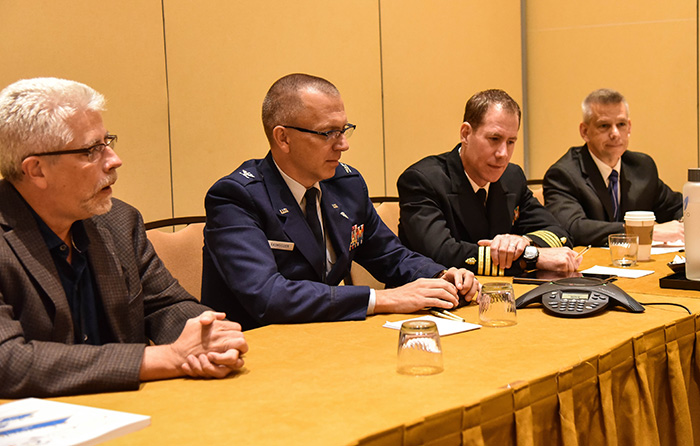Staying Alive in the Era of Modern Trauma

Collaboration, partnership, synergy, preparedness - although fairly familiar terms with relatively simple meanings, these words have much greater significance this week at the 2016 Military Health System Research Symposium being held in Kissimmee, Florida, Aug. 15-18.
With a focus on trauma care and an end goal of zero preventable deaths, staying alive in the era of modern trauma and translating life-saving battlefield advances to the civilian homefront has spurred meeting efforts and conversations forward this week; specifically during a scheduled media roundtable on Aug. 16.
On Tuesday, media phoned in to be a part of a media roundtable involving expert panelists Col. Todd Rasmussen, director of the U.S. Army Medical Research and Materiel Command's Combat Casualty Care Research Program; Capt. Eric Elster, professor of surgery at the Uniformed Services University of the Health Sciences; Dr. Sylvain Cardin from the Naval Medical Research Unit in San Antonio, Texas; Dr. Frank Butler, chairman of the DOD Committee on Tactical Combat Casualty Care, U.S. Navy retired; and Dr. John Holcomb, vice chair of the Department of Surgery, University of Texas Health Science Center at Houston, U.S. Army retired.
"I think it's important for those on the line to recognize that what is present here is a really unique coming together of three or four different groups that, I believe, provide particular synergy in the area of medical research for the Warfighter," Rasmussen began.
The MHSRS is the Department of Defense's premier scientific meeting; a platform with the intent of inspiring communication and collaboration between the uniform population, the civilian academic population and the civilian innovators and industry population.
"Bringing all of those groups together in one venue for three or four days – in which the military can present its top needs and priorities as far as medicine and trauma and injury care – it provides a really unique venue and we hope that it provides a unique amount of synergy for medical research and innovation," Rasmussen continued.
Trauma today is the number three overall cause of death in America. From the time you are born until the time you reach middle age, the odds are that you are more likely to die from massive blood loss than anything else. From active-shooter situations to basic common injuries, military researchers believe the life-saving techniques being used on the battlefield can also benefit the civilian population on the homefront resulting in a stronger, more resilient American public.
"I think there's a real pull in the civilian sectors for those lessons," added Rasmussen, "They want to understand what the military has done."
"If you look at this from a historical perspective, Hypocrites said, 'If you want to be a surgeon, call an Army;' and the advances that have come out of the crucible of conflict have changed medicine from the very beginning of time. We're seeing the ability of those lessons to be translated much quicker, we're seeing the transfer being sustainable," added Elster. "If you look at what the military has accomplished over the last decade and a half of conflict and those advances, it's the Nation's return on investment, and it is incumbent on us to make sure those advances exist in both systems because they benefit civilian patients as well."
"We want to have zero preventable deaths, zero potentially-survivable deaths from trauma and injury," said Rasmussen. "Is it a far reach? Sure, it is. It's a lot of work and a high goal, but that's what sets medicine and medical research in this country aside. It's not, to me, any different than the goal of curing cancer."
We live in changing world, an international reality of intentional acts of violence. Active-shooter situations are no longer reserved for the battlefield, they are happening right here, on the homefront. In the wake of recent violent attacks, civilian healthcare is now recognizing improvements in pre-hospital care that need to be made. Improvements that, as Rasmussen stated, "better mirror military pre-hospital care for unfortunate situations like these that are now a part of our reality."
Sitting in our meeting room in Kissimmee, only miles away from Orlando and the recent active-shooter attack on a nightclub that resulted in the deaths of 49 civilians, we beg the question "What do civilians need to know to stay alive?"
"As we go forward, preparedness is key, and timing is of the essence" stated Cardin matter-of-factly.
"I think we get there by enabling and educating the public to be active; not bystanders, but participants in reaction to these scenarios," added Rasmussen.
"You see on the battlefield that a Soldier, Airmen, Marine will put the tourniquet on their buddy before putting a tourniquet on themselves," added Elster. "I think that's something that the average American would also do if they had the education and the resources available to do it."
"And if it was a point of emphasis nationally, and I think now it is," added Rasmussen adamantly.
Referencing the National Stop the Bleed campaign that was initiated by the White House and is now being propagated across the country, the panelists commended the present emphasis apparent throughout America to educate and promote preparedness. Through the education and training of the American public, we can equip those citizens with the tools and skillset required to no longer be bystanders; to be active participants in situations of distress and to potentially save the lives of their fellow citizens.
Panelists also stressed the role the press plays in this effort to those media on the line, noting the obvious and important impact what they report has on the public at large.
"I think the press plays a role in this," said Rasmussen. "To me, it's going to be important nationally and the media could really play a role in helping mankind. It's a big deal, you could save lives by making this known to the public and letting them consider this and then it'll be what it'll be but, I suspect, it'll be life-saving."














